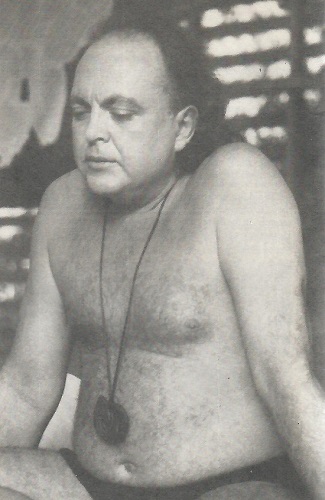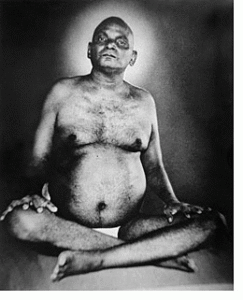
The Journal of the Free Daist Communion, Vol 5, NO 10, November/December 1986



You have observed in me the expanded abdomen. Even when I lose weight, typically my abdomen quite naturally appears relatively expanded. Likewise, you have seen pictures of people like Nityananda and Rang Avadhoot.


Even some pictures of Muktananda show this quality. Yogis who are fully awake often show the Shakti, or the Spirit-Current, in their abdomenal swelling. Even yogis who are relatively light in weight show this expansion, certainly at times. It is a phenomenon that can be cultivated intentionally through Yogic practices, and it is also a process that can develop spontaneously in the course of Yogic practice.
As you already know, you should have the bodily sense of breathing fully to the lower abdomen and the bodily base. Therefore, your orientation is not to the concave abdomen or even particularly to the “washboard” look of a weight-lifter. You may not develop an abdomen that appears very expansive, but it should naturally be soft and generally convex, and your breaths should be to the abdomen.
A traditional process sometimes takes place spontaneously and sometimes is engaged intentionally—you may find that it is happening rather automatically, and there may be other times when it is useful to do it intentionally. It is called by several names—”bellows breathing”, or “vase breathing”, or simply “the vase”, or “the pot-shape”, referring to the way the abdomen looks when it is pressed outward by the internal energy and breath.
The traditions that give the process its various names tend also toward the traditional orientation or purpose for such exercises. Your practice of “conductivity” bears some likenesses certainly to the traditional process, but it may also be distinguished from some of the traditional purposes or pursuits. Even so, as I have already suggested in The Dawn Horse Testament and in other instructions over the years, it may be useful to practice conductivity in the manner of the pot-shape, or the vase, or bellows breathing.
The process can be done as a preliminary to meditation and at intervals in meditation. It involves the cycle of conductivity usually associated with inhalation via the frontal line to the base, and then exhalation via the spinal line to the brain-core, or the Ajna Door, and the crown and above, with some additional orientation, which I will describe.
Inhale in the Life-Current, fully, via the nostrils, with the tongue rested at the roof of the mouth. Inhale fully through the frontal line to the lower abdomen, feeling the Spirit-Current and the breath expanding down through the frontal line, opening knots and relaxing tensions. Press the breath down into the abdomen, even so that the abdomen expands rather fully. As the breath enters the abdomen and begins to swell, the breath should be held and left in the abdomen, the bodily base should be tensed or contracted upward, and the chin may be pulled down somewhat to lock the breath at the throat. Hold the breath in the abdomen for a significant period, while concentrating attention at the Ajna Door.6
6. The “Ajna Door”, also known as the “single eye”, the “mystic eye”, or the “third eye”, is the subtle psychic center or chakra located between and behind the eyebrows and associated with the brain core. The awakening of the ajna chakra gives rise to mystical visions and intuitive reflections of other realms of experience within and outside the individual. The ajna chakra governs the higher mind, will, vision, and conception and is also referred to as the “Guru’s Seat”, the psychic center through which the Heart-Master “contacts” the devotee with his Spirit-Baptism or Blessing.
After a few moments, even after a full breath, it may be possible to inhale even a little more. Release the chin-lock and inhale further into the abdomen while maintaining the tension in the bodily base (perhaps, if it is uncomfortable to hold it beyond a point, periodically briefly relaxing the tension in the bodily base and then re-tensing). In these attempts to inhale more, the abdomen can be “rolled” in and out, tending to loosen the sensation in the abdomen and the solar plexus so that more air and more energy can be breathed down.
Hold this mudra,7 this vase, this pot-shape, until, because of discomfort, it becomes necessary or inevitable to exhale.
7. A “mudra” is a yogic posture or bodily pose, especially of the hands. Da Love-Ananda also uses the word “Mudra” to indicate the Sign, Attitude, or Disposition of Enlightenment.
Then shoot the breath upwards via the spinal line to the Ajna Door and above, exhaling in a relaxed fashion rather than quickly, but still generally in a shorter time than the inhalation. Upon exhalation, allow the breath to be held out for a time instead of taking the next inhalation, still keeping attention at the Ajna Door and above, with the feeling of releasing the Life-Current upwards at the Ajna Door and above. Or inhalation can follow immediately after the full exhalation.
The exhalation should be full. It should have the sensation of shooting or throwing the breath or the energy up and out. It should not be quick. It should take some time, it should be done in a relaxed fashion, but it should generally take a shorter period of time than the inhalation. The exhalation can be held for a significant period, for however long it feels comfortable or useful. Then the same cycle can be repeated.
Do this exercise a few times, or for a few minutes, as a preliminary to meditation, until the Spirit-Current is felt as a full force of Bliss rising in the body to the Ajna Door. Once the Inherent Bliss of the Spirit-Current is felt to rise, whole bodily, via the spinal line, and felt as pressure at the Ajna Door—in other words, when there is full connection with the Inherent Bliss of the Spirit-Current—then the purpose of this preliminary form of conductivity has been served. You should then simply go on to the rest of the meditative process, including the forms of conductivity you would otherwise naturally apply in meditation without holding the breath either in or out, but continuing to draw the Spirit-Current upwards via inhalation in the spinal line, as well as shooting it upwards via exhalation in the spinal line.
This practice, done as a preliminary to meditation or at the early stage of meditation, and perhaps done occasionally at intervals in meditation if it is felt necessary and useful, intensifies the reception of the Spirit-Current. It releases the Spirit-Current from the knots in the frontal line, and it establishes upward conductivity of the Spirit-Current. You need not do this exercise every time you sit for meditation, but be sensitive to the body-mind, and engage this exercise especially when the rising Bliss of Shakti is weak, or when it feels trapped in the frontal line.
This practice, like all other forms of your practice in this Way, should be done while surrendering to, and feeling, and even visualizing, the Ishta-Guru, even His Bodily Form, His Whole Body, or perhaps just His Face, or perhaps just His Feet. The Ishta-Guru, the Form of the Divine Person, should be felt in front of the body-mind and all around it. It should be felt as the body-mind. It should be felt within the body-mind. And when felt within the body-mind, it should especially be felt in the heart, or above the head, or at the brain-core.
As I said, it is good to use this exercise of conductivity, with some holding of the breath in or out, at the beginning of meditation, perhaps after using the hamsadanda for a period, and also at appropriate intervals. It may be done along with the other practices of your meditation, even until deep meditation begins to develop, or even until natural and spontaneous kumbhak8 or retention of the breath, in or out, or even until Conditional Nirvakalpa Samadhi.9
8. The most common form of “kumbhak” (Sanskrit: “kumbhaka”) is the momentary retention of the breath between exhalation and inhalation, or between inhalation and exhalation. In its most extreme form “kumbhak” is a temporary suspension of the breath altogether. “Kumbhak” is sometimes intentionally practiced as a form of “pranayama”, or control of the breath, though this process may also occur naturally in response to the Grace of Spiritual Transmission.
9. The Sanskrit term “Nirvikalpa Samadhi” means literally “formless ecstasy”. It is the traditional goal of the many schools of yogic ascent, belonging to the fifth stage of life. Da Love-Ananda distinguishes between the fifth stage phenomenon of “Conditional Nirvikalpa Samadhi” and the seventh stage Realization of Sahaj Samadhi, which leads to what he calls “Bhava Samadhi”. “Perfect Nirvikalpa Samadhi”, or “Translation” (see below). Da Love-Ananda writes:
“Conditional Nirvikalpa Samadhi is an attainment that arises as the result of the application of fifth stage yogic means—or the exclusive ascent of attention above the mechanisms of the body-mind. By such means, the manifest modifications of the Life-Current are avoided by the conscious being, so that the condition of the Life-Current prior to modification is enjoyed. However, it is an ‘unnatural’ or forced state of attention, as compared to the ‘natural’ or native recognition of attention and objects in the Sahaj Samadhi of the seventh stage. Thus, when the states of the body-mind are reapproached by the mechanics of attention, the ‘Realization’ of the Nirvikalpa state is lost again” (January 12, 1981).
More:
BREATH, BODY, FEELING, EMOTION, ATTENTION and MIND
The breath is the link between all of the primary faculties of the body-mind. It is a physical act. Therefore, it is associated with the body. It is a feeling matter. Therefore, it is associated with emotion. It requires attention. Therefore, it requires the leading faculty of mind. The practice is not to direct body, emotion, and attention to the breath, however. It is to direct all those, and the breath, toward Me. It is a matter of participating in Me, entering fully into relationship to Me, concretely, with all the faculties yielded.
First there is your response to Me, but then you must learn this artful, and in some ways technical, practice, by progressive adaptation. Just that adaptation is part of the beginners practice of the Way of the Heart. You must consistently apply yourself, and you must study My Instruction.
In the Way of the Heart, the breath is simply a way to participate in your devotional relationship to Beloved Adi Da. Simply breathe, and feel Him. Surrender to Him, and feel that you are receiving conscious, revitalizing, and transforming life-energy when you inhale, and that you are releasing accumulated tensions, toxins, and negative psychological and emotional conditions when you exhale.
This process of reception-release is the effective means by which you can realign and reintegrate your physical body with the etheric dimension in which your body arises, thus enlivening and balancing the physical body in the most effective manner possible. The practice of the breath, or of such reception-release, is to consciously release all negative, tense, contracted, obstructed, and sluggish conditions of body, emotion, and mind, and receive the enlivening, healing, transforming, fluid, and intensifying force of life itself.
It is natural to align the process of reception-release to the cycle of the breath. Even involuntarily, you allow the force of life to enter and fill the body with the inhalation, and you release at least the physical wastes with exhalation. In the process of reception-release that Beloved Adi Da Instructs His devotees to engage, this purifying process is amplified through feeling-Contemplation of Him, reception of His Heart-Blessing, and release or surrender of self. >>>